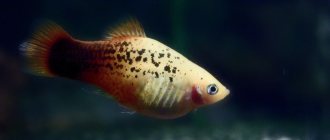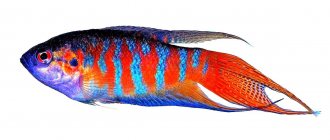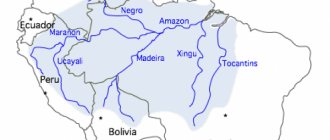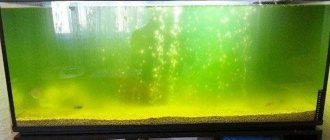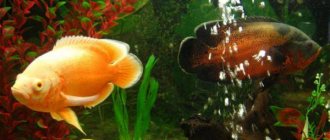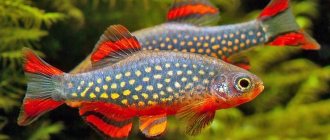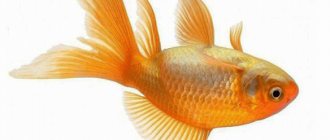Description and characteristics
Most labyrinth fish have a similar external description, which allows them to differentiate their phenotypes from regular fish. The following external signs are characteristic of representatives of the order Perciformes:
- oblong elongated body, slightly compressed from the sides;
- pectoral fins are most often thread-like;
- small head with small mouth;
- long dorsal fins;
- the presence of a labyrinthine organ in the epibranchial cavity.
It should also be noted that labyrinth fish have a rich and unique color, which makes them stand out from their counterparts. Phenotypes use pectoral fins as organs of touch for movement, and the presence of a labyrinth organ allows fish to inhale air - labyrinth fish swim to the water surface and draw in oxygen. In addition, representatives of the species are able to exist for a certain number of minutes without liquid.
What are their main characteristics?
Externally, labyrinth fish are practically no different from the rest. When purchasing them for your aquarium, it is not always possible to find out their characteristics. But there is a difference, and it will certainly appear if for some reason the amount of oxygen in the water decreases significantly.
The fact is that most fish have a gill breathing system. The blood receives oxygen obtained from the water in the gills. Naturally, when the chemical composition of water changes towards a decrease in the percentage of oxygen, such biological species begin to experience a state of hypoxia.
Labyrinth fish (lat. Anabantoidei), otherwise slide-shaped, have a special organ of the respiratory system - a labyrinth. These are special plates located in the gill slit, abundantly supplied with a network of blood vessels. Floating to the surface of the water, such individuals swallow atmospheric air through their mouths, it enters the labyrinth and, through an extensive network of capillaries, penetrates the bloodstream.
That is why, for a prosperous life, these species do not need massive aeration of water and a wealth of flora - a supplier of oxygen in the aquatic environment. They do not need large volumes of water per individual; the fish can exist in a fairly small space, the main thing is that the temperament of their neighbors does not differ much from their own.
Although it is a mistake to think that plants are not needed in such an aquarium. These fish love to sit in the shade of spreading plants, hiding from surprises and watching their neighbors from the thickets. In addition, the plants divide the territory of the water house into separate zones, moving between which they can get a lot of interesting impressions.
Popular aquarium varieties
The labyrinth family includes many species of fish that have gained fame and love in aquarium circles. In turn, species are divided into varieties and categories depending on their feeding method: some representatives grab food at the surface of the water surface, while others “lunch” at the bottom or from the substrate. Popular varieties of labyrinth aquarium fish:
- Bettas - the variety acquired its name due to the pugnacious behavior of the males. Cockerels behave especially violently during spawning or mating games. Life expectancy is up to 3 years, provided that the pets are kept in proper conditions. In addition to their violent temperament, bettas are known for their unpretentiousness and bright colors.
- Gourami are labyrinthine aquarium fish, among which honey, pearl and spotted gourami are especially popular. Almost all species grow up to 15 cm, and are extremely unassuming. The only slight drawback of gourami is that the phenotype loves to eat algae for the aquarium, and is also jumping, so the tank with gourami is equipped with a lid or mesh.
- Macropods are fish with a bright green-violet color with orange stripes. Macropods are very prolific, and the temperament of the fish is as indomitable as that of bettas.
- Lalius are aquarium labyrinth fish that are medium in size: the phenotype grows up to 6 cm in length. The color of Lalius consists of turquoise tones with scarlet spots on the fins. The character of the fish is modest, even timid, so lalius spend a lot of time in the thickets of flora or in shelters.
- Labioses - the phenotype has a second name: labial coliosis. Externally, labioses are similar to laliuses; in a tank, the fish reach 8 cm. The color is silver-greenish, the front part is colored purple, and the back part is blue.
About the most typical representatives
What types of aquarium inhabitants have such an advantageous organ? Can live in oxygen-deficient conditions:
- gourami (pearl, silver, grumbling, chocolate);
- cockerel;
- lalius;
- chelostoma;
- ctenopoma;
- trichopsis and a number of others.
Trichopsis
They all have a fairly representative appearance, swim slowly and importantly, prefer to be in the middle layers of the water, but love to examine interesting details of the bottom. They are not indifferent to underwater caves and driftwood, and are interested in the structure of shells and crystals. They will be grateful for decorating the bottom with corals and artificial designer souvenirs.
The body is elongated, flattened on the sides, the head is small, the fins are well developed and protruding.
The coloring of most representatives is bright and eye-catching, especially in males during the spawning period.
Some of these fish (for example, cockerels) are quite combative in nature and will not be able to find a common language with all their neighbors. Gourami are peaceful and seasoned aquarium fish, unpretentious and unpretentious. The complete opposite is the macropods popular among aquarists (striped, blue, red, albino and even black) - often aggressive and cocky.
In nature, fish capable of living without oxygen live in rice fields, fairly polluted and shallow water bodies, even deep puddles.
In an aquarium, for a comfortable life, you need soft and acidic water, the presence of plants with large leaves (males often prefer to build nests for eggs on their lower surface) and dim, diffused lighting. Water temperature does not matter much if this is not the period of preparation for spawning. The best range is from 20 to 22o. To maintain the brightness of the color, it is necessary to change a third of the water every two weeks, although this is not necessary for health.
Keeping in an aquarium
The maintenance of labyrinth fish in a home pond is almost the same as that of other phenotypes, except for one nuance - the phenotypes are jumping, so the tank is equipped with a lid or mesh. The size of the pond for pets is chosen depending on the requirements of certain species, the same goes for design and water parameters. The optimal temperature range in the tank ranges from 23 to 26C; it is also important to carry out timely water changes and check nitrate levels. The presence of a compressor and a powerful filtration system for keeping labyrinth fish is not required, and is installed at the request of the owner, or if other inhabitants of the aquarium require it.
Aquarium labyrinth fish prefer dense thickets of vegetation, so the owner needs to plant many different types of flora, leaving a swimming area. Floating species are especially important for pets: duckweed or pistia, in which pets will build nests. Decorative elements for the aquarium are selected depending on the taste preferences of the owner.
Character and livability
Creepers exhibit moderate activity and aggression. The restless nature creates problems of species compatibility. The best candidates for neighbors are calm species in which they grew up. Character is predominantly formed by the “social” environment, which provides guidance for behavioral forms.
An excessively small aquarium volume and water changes can contribute to hostility. They react negatively to new neighbors. The key to peaceful coexistence of individuals is “old” water. That is why it should be renewed in small portions; the influx of new clean ones stimulates reproduction, which naturally increases the level of aggressiveness.
Reproduction
Labyrinth fish are able to reproduce both in a common and in a separate tank, but it is preferable to breed pets in a hatchery for the safety of the offspring. Half a month before spawning, the pairs are placed in separate containers and intensively fed with live food for stimulation. Then comes the time to build a nest, which different representatives create in their own way: from saliva, air bubbles, algae residues or even oil. Typically, nests are built by male fish.
After spawning, the females are removed from the fish tank, and the small fish are taken care of by the males. When the babies begin to swim freely, the remaining parents are also put back, and the fry are fed with live dust.
Representatives of the labyrinth family are active and nimble fish with intense colors, which have gained popularity among aquarists due to their unpretentiousness, ease of reproduction and good-looking appearance. In order for fish to live long in a home pond, you should choose the right neighbors and carefully care for your pets.
Labyrinth fish for your aquarium
Labyrinth or creeper fish from the suborder Perciformes are predominantly freshwater and live in Africa and Asia. The labyrinthine family includes more than 30 species of fish, which are distinguished by their individual body structure, which has a labyrinthine organ. With the help of this organ, fish additionally breathe atmospheric air and can live even in dirty reservoirs with insufficient oxygen.
Diseases of labyrinth fish
Representatives of this family, like other aquarium inhabitants, can contract diseases caused by poor care or some pathogen. Diseases occur for several reasons:
- Physical: poor care, inappropriate water, incorrect temperature.
- Chemical: poisoning.
- Physiological: improper feeding.
Gourami, Cockerel and Lyalius fish suffer more often than others from viruses, worms and bacteria. The most common disease is heteropolariasis. It is provoked by a single-celled ciliate that affects the eyes, lips and fins. As a result, these lips are covered with white fluff, similar to cotton wool. This infection is not very dangerous and can be easily treated: the sick individual is placed in a separate aquarium, treated with an antibiotic and a solution of malachite green.
The cockerel is highly susceptible to hexamethosis. The disease initially affects the intestines, then spreads to other organs. Even death is possible. Metronidazole is used as treatment, which must be added to water and food. The water temperature during treatment should vary between 30-34ºС.
Ichthyophthyriosis is a disease caused by a single-celled parasite. Its habitat is gills and scales. The disease can only be seen several days after infection. Main features:
- The fins are compressed and scratched, covered with mucus.
- The body is covered with white spots.
- The fish constantly rushes between the bottom and the surface of the water.
For treatment, you should raise the water temperature to 32ºC, change it three times a day, and add the Anti-Steam preparation.
Labyrinth fish
One of the most interesting groups bred in artificially created conditions are labyrinth aquarium fish. The modern name of the suborder is Creepers (lat. Anabantoidei). A special feature of representatives of this group is the presence of an additional epibranchial organ (labyrinth), which allows them to use air captured at the surface and exist in oxygen-depleted water. The organ formed in the evolutionary process allows it to survive in harsh environmental conditions. The most popular types of labyrinth fish for an aquarium are:
Cockerels
cockerel fish
There are many types and breeding forms, which are quite different. All male bettas are known for their pugnacious nature. And they were actually used for fish fights. And it is the males that have brighter fins that look like a veil. And the angrier the cockerel, the brighter its fin.
The homeland of cockerels is the waters of Indonesia. In an aquarium, cockerels fight when they are separated from females before spawning, and when arranging a nest, all fish are driven away.
But for spawning, not the brightest, but the largest and youngest (7-9 months) males are selected.
To stimulate the reproduction of labyrinth fish, you need a special spawning aquarium with a capacity of about 10 liters. The water in it should have a temperature of 27-28 degrees. You will also need a bunch of riccia, which the cockerels use to build a nest.
In the spawning area, the male and female are fed live food. After building the nest, the pair begins to spawn. At the same time, she goes to the bottom, and the male picks up the eggs in his mouth and puts them in the nest. After this, the female is removed, and the male remains to monitor the offspring. It is separated only after the fry swim on their own.
The life expectancy of cockerels reaches three years. Their color depends on the fish being crossed. In monochromatic fish, the offspring will be like this, but if you select multi-colored fish for spawning, you will get a mixture of colors.
Cockerels eat both dry and live food. They are often used as cleaners for an aquarium where there are too many snails. The cockerels quickly cope with this overpopulation.
